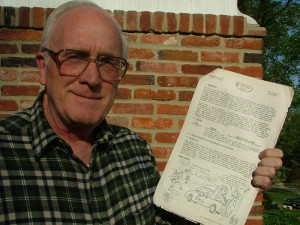 David Hoadley is widely regarded as the first storm chaser, because he was the first to travel long distances, stay overnight on the road, and make his own forecasts. He began chasing in Bismarck, North Dakota as a teenager in 1956, long before the Interstate, satellites, laptops, or cell phones. Except for 1966, he has chased every year since then. The first tornado that he photographed was a rain-wrapped cone near Wing, ND in 1958.
David Hoadley is widely regarded as the first storm chaser, because he was the first to travel long distances, stay overnight on the road, and make his own forecasts. He began chasing in Bismarck, North Dakota as a teenager in 1956, long before the Interstate, satellites, laptops, or cell phones. Except for 1966, he has chased every year since then. The first tornado that he photographed was a rain-wrapped cone near Wing, ND in 1958.
In 1977, David originated the idea for a storm chaser’s newsletter and began the paper version of Storm Track. In addition to his commentaries and chase-related cartoons, the newsletter provided the first national forum for chasers to share stories, skills, and concerns from across the country. While providing valuable information on chasing technique and photography, Storm Track also emphasized chaser ethics and helped shape this developing culture. Some of his colleagues call him the “father of storm chasing.” He gave up that editorship in 1985, and the newsletter continues today in its online incarnation at stormtrack.org.
David was a career Federal employee in Washington, D.C. with the water quality program of the Environmental Protection Agency, retiring in 2003 after 39 years. His storm chase writing and photography have been published in national and international books, magazines and newspapers, including one U.S. stamp in 2004, and he has appeared on network television. David continues chasing a few weeks each year from his Virginia home, adding to a lifetime record of 224 tornadoes over 832,000 miles. In 2013, he photographed both the El Reno, OK and Wayne, NE tornadoes, aided by forecast techniques that he developed over many years, based on surface data. He brings to the project his extraordinary depth of experience, analytical skills and forensic approach to reconstructing storm evolution, developed over more than 5 decades.
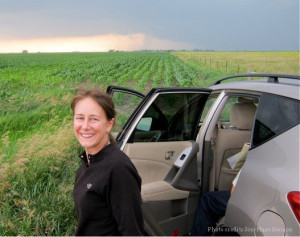 Dr. Tracie Seimon’s day job is as a molecular scientist working with the Wildlife Conservation Society at the Bronx Zoo in New York City, where she leads projects in wildlife health and conservation focused on some of the world’s most iconic and endangered wildlife species. She enjoys weather and wildlife photography and started chasing storms with her husband Anton Seimon in 2003. She saw her first tornado in Minitare Nebraska in 2003 and has been hooked ever since. She has photographed tornadic storms of the past 10 years such as Belleville, Kansas in 2004, La Grange, Wyoming in 2007, Quinter, Kansas in 2008, Campo, Colorado 2010 (with her “dream shot” of a statuesque white tornado framed by a double-rainbow), and most recently, the 2013 El Reno, Oklahoma storm itself. Her story of tagging trees during the 2013 El Reno tornado encounter can be found here. For the project Tracie will compile and analyze video and still imagery for the research database and assist in the generation of products for display on this website.
Dr. Tracie Seimon’s day job is as a molecular scientist working with the Wildlife Conservation Society at the Bronx Zoo in New York City, where she leads projects in wildlife health and conservation focused on some of the world’s most iconic and endangered wildlife species. She enjoys weather and wildlife photography and started chasing storms with her husband Anton Seimon in 2003. She saw her first tornado in Minitare Nebraska in 2003 and has been hooked ever since. She has photographed tornadic storms of the past 10 years such as Belleville, Kansas in 2004, La Grange, Wyoming in 2007, Quinter, Kansas in 2008, Campo, Colorado 2010 (with her “dream shot” of a statuesque white tornado framed by a double-rainbow), and most recently, the 2013 El Reno, Oklahoma storm itself. Her story of tagging trees during the 2013 El Reno tornado encounter can be found here. For the project Tracie will compile and analyze video and still imagery for the research database and assist in the generation of products for display on this website.
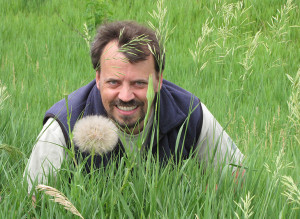 A native of South Africa, Dr. Anton Seimon is an environmental scientist with extensive experience in meteorological and lightning research. When not roaming the plains seeking out elusive masses of rotating water vapor, he coordinates long-term monitoring efforts on climate change impacts on high alpine watersheds in the Peruvian Andes, studies present day and past tropical Andean climates, and works with conservationists to plan for climate change in tropical Africa using high-resolution Earth System models.
A native of South Africa, Dr. Anton Seimon is an environmental scientist with extensive experience in meteorological and lightning research. When not roaming the plains seeking out elusive masses of rotating water vapor, he coordinates long-term monitoring efforts on climate change impacts on high alpine watersheds in the Peruvian Andes, studies present day and past tropical Andean climates, and works with conservationists to plan for climate change in tropical Africa using high-resolution Earth System models.
Working with Tim Samaras, Dr. Erik Rasmussen and many other notable chasers, he coordinated the “Inside Tornadoes” research initiative in the Midwest under funding from the National Geographic Expeditions Council. The project continued for 3 years, culminating in the legendary intercept by Tim’s team of the Manchester, South Dakota F4-intensity tornado, profiled as cover story of National Geographic Magazine in April 2004. In 2003 he joined Tim in deploying an instrumented probe near Stratford, Texas, yielding precise measurements of pressure inside a multivortex tornado. Anton’s study of the 1990 Plainfield, Illinois F5-intensity tornado identified how a totally unexpected, high-mortality tornado was preceded and accompanied by highly anomalous cloud-to-ground lightning activity. He plans to utilize our project database to perform similar analysis on the El Reno storm, with the added benefit of multi-perspective visual documentation of lightning activity unavailable for the Plainfield event. A veteran of 20 seasons of Tornado Alley chasing, he ventures to the high plains each spring with Tracie and their two chase hounds. Both have the good fortune to share and witness some of the most iconic tornadic storms of recent years.
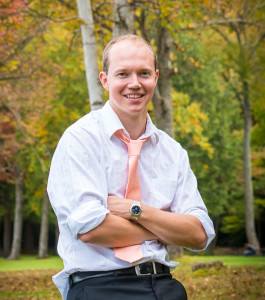 Hailing from Australia, Dr. John Allen is a severe weather researcher and storm chaser who has had an avid interest in severe thunderstorms since age 6. He began storm chasing in 2003, and is now an accomplished Australian storm chase photographer. Chasing in Australia requires a detailed attention to the forecast, with limited remote data much like that seen in the United States in the 1990s. Learning from this experience, in 2010 he first travelled to the Great Plains of the United States to chase, and has been returning ever since, ranging over 60,000 miles of the continent. He has seen 73 tornadoes between the two continents and continues to chase each year, and observed the El Reno, OK tornado in 2013. John maintains a chasing and photographic blog . His photography has appeared in textbooks as well as other media, and he has appeared in interviews on network television and in major print media.
Hailing from Australia, Dr. John Allen is a severe weather researcher and storm chaser who has had an avid interest in severe thunderstorms since age 6. He began storm chasing in 2003, and is now an accomplished Australian storm chase photographer. Chasing in Australia requires a detailed attention to the forecast, with limited remote data much like that seen in the United States in the 1990s. Learning from this experience, in 2010 he first travelled to the Great Plains of the United States to chase, and has been returning ever since, ranging over 60,000 miles of the continent. He has seen 73 tornadoes between the two continents and continues to chase each year, and observed the El Reno, OK tornado in 2013. John maintains a chasing and photographic blog . His photography has appeared in textbooks as well as other media, and he has appeared in interviews on network television and in major print media.
John’s research career has focused on synoptic and mesoscale climatology, exploring topics ranging from rapid cyclogenesis to climate influences on the environments of severe thunderstorms. He completed his PhD in 2012 at the University of Melbourne examining the impacts of climate variability and change on severe thunderstorm environments in Australia’. More recently, John has worked on exploring seasonal prediction for tornadoes and proxy-climatologies of hail for the United States, along with developing a new historical climatology of Australian tornadoes. He is currently based at the International Research Institute for Climate and Society, Columbia University, New York. For the project John plays a central role in creation and visualization of the database, and is keen to explore how the synchronized observations we develop can be used to analyze storm scale dynamics.
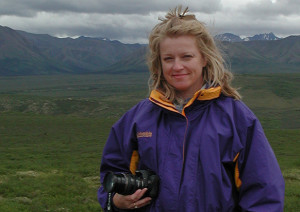 Born in Austria, Elke Edwards recalls a fascination with storms for as long as she can remember, and growing up in Colorado presented almost daily opportunities for her to enjoy them every summer. The first thing she looked up on the World Wide Web was “thunderstorms”. The information Elke found there merely stoked her curiosity. She took a weather spotter class in 1995, shortly thereafter achieved her Amateur Radio Technician license, and began 6 years of observing High Plains thunderstorms with a whole new perspective. Within the storm chaser community she met many researchers and other interesting people, and was fortunate to participate in some tornado research field projects, including the National Geographic-funded “Inside Tornadoes” initiative with Tim Samaras, Anton Seimon and Dr. Erik Rasmussen. These experiences have inspired a strong commitment to supporting severe storms research. In 2002 she married “her very own” NOAA Storm Prediction Center lead forecaster,” Roger Edwards, and now makes her home in Norman, Oklahoma. Like the rest of the El Reno team, Roger and Elke roam the plains to observe storms for several weeks each spring.
Born in Austria, Elke Edwards recalls a fascination with storms for as long as she can remember, and growing up in Colorado presented almost daily opportunities for her to enjoy them every summer. The first thing she looked up on the World Wide Web was “thunderstorms”. The information Elke found there merely stoked her curiosity. She took a weather spotter class in 1995, shortly thereafter achieved her Amateur Radio Technician license, and began 6 years of observing High Plains thunderstorms with a whole new perspective. Within the storm chaser community she met many researchers and other interesting people, and was fortunate to participate in some tornado research field projects, including the National Geographic-funded “Inside Tornadoes” initiative with Tim Samaras, Anton Seimon and Dr. Erik Rasmussen. These experiences have inspired a strong commitment to supporting severe storms research. In 2002 she married “her very own” NOAA Storm Prediction Center lead forecaster,” Roger Edwards, and now makes her home in Norman, Oklahoma. Like the rest of the El Reno team, Roger and Elke roam the plains to observe storms for several weeks each spring.
Elke has worked in web and graphic design for 20 years and has owned and operated her own business, Insojourn Design and Images, LLC, since 2004. She is layout editor, webmaster, and treasurer at the E-Journal of Severe Storms Meteorology, a non-profit open-access peer-reviewed science journal publishing since 2006. She brings these skills to the El Reno Survey project as webmaster, and also serves as our unofficial liaison to the Norman tornado research and operational warning communities.
